
Last night, Saturday, October 28 as I write this, was the night of the Hunter’s Moon – that early-rising, full, bright orb that appears a month after the harvest moon, which this year fell on September 29. So it seems like a good time to write about lunar things, and in particular why we human beings are so fascinated by them.
I can imagine our earliest ancestors looking skyward in awe at the moonrise, wondering what on earth that thing in the sky might be. A god? A demon? An omen?
The association of the moon with the eternal and divine has been a part of human culture for eons. The Encyclopedia Britannica calls moon worship “a widespread phenomenon, appearing in various eras and cultures,” which has ”engendered a rich symbolism and mythology.”

Classical gods were endlessly changeable; there have been at least several moon goddesses through the millennia, including Luna, Selene, Diana, Proserpine, Artemis and Hecate. They were often believed to be the mates or counterparts of the male gods who inhabited the sun. These goddesses have been endlessly depicted in art, from ancient to modern times. Wikipedia lists more than twenty gods under “Lunar Deities” – not all of them female, however; the “Man in the Moon” is considered in many cultures to have been banished there for having committed some crime or lapse in faith. (According to Jewish lore, he was caught gathering sticks on the Sabbath. )
I prefer happier tales, like the one that features the Greek moon goddess Selene piloting her moon chariot across the sky. She had several lovers, including Endymion, subject of a 4000-line poem by the British Romantic Poet John Keats.

The moon has always fascinated me. I like it especially in the daytime, in a clear blue sky, when it hovers above like a harbinger of more interesting times to come. At night, I love to see the spreading colors it makes when wrapped in wispy clouds.

I adore things that happen only in moonlight; the moon illuminated some of my earliest adventures, for better or worse. With age, I’ve also come to rely on the moon for guidance. Our pupils dilate less in the dark as we grow older, which can make it difficult to see. Thank God for the moon, especially when it’s at least close to full.
On the other hand is the moon’s dark side, its eclipses, its phases: New moon (which is really no moon at all), waxing crescent, first quarter, waxing gibbous, full moon, waning gibbous, third quarter and waning crescent. Every month, the moon provides an allegory in the night sky for the waxing and waning of our own lives. The moon regulates the ocean tides. Much has been said and written, true or false, about the connection between the moon and menstrual cycles.

The arrival of the full moon has long been associated with bizarre human behavior and physical oddities; in Shakespeare’s “Othello,” the moon is all but blamed for murder. “It is the very error of the moon. She comes more nearer earth than she was wont. And makes men mad.” The Latin word for moon, luna, is the likely source of such English words as “lunatic” and “looney.”
There is another aspect to humanity’s long relationship to the moon, of course – one that has exploded in the last century or so, though it goes back much farther than that: I mean our irrepressible inclination to sing and make music about it. The list of moon music written in English alone is too long to count (one of my favorite moon songs, French composer Claude Debussy’s beautiful 1905 solo piano piece Clair de Lune, or Moonlight, wouldn’t even qualify, for example), but here is a partial list, along with some of the artists who made the songs famous:
Moon River Audrey Hepburn
Moondance Van Morrison
Moonchild King Crimson
Bad Moon Rising CCR
Fly Me to the Moon Frank Sinatra
Harvest Moon Neil Young
Brain Damage Pink Floyd (No mention of the moon is made in the actual title of this dark track, yet it’s full of lunar references and may be the best-known moon song of the last half-century.)
Moonshadow Cat Stevens
Moonlight Drive The Doors
Shame on the Moon Bob Seger
Half Moon Janis Joplin
The Moon’s a Harsh Mistress Glen Campbell
Moon at the Window Joni Mitchell:
Beautiful Moons Ago Nat King Cole
No Moon at All Diana Krall
Moonlight Feels Right Starbuck
Howlin’ at the Moon Hank Williams
Blue Moon of Kentucky Elvis Presley
How High the Moon Les Paul and Mary Ford
Moonlight Serenade Glenn Miller
Blue Moon Billie Holiday, 1952
Once in a Very Blue Moon Nanci Griffith

–Kevin
